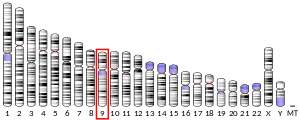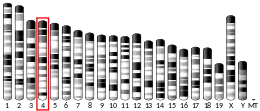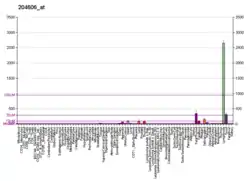CCL21
Chemokine (C-C motif) ligand 21 (CCL21) is a small cytokine belonging to the CC chemokine family. This chemokine is also known as 6Ckine (because it has six conserved cysteine residues instead of the four cysteines typical to chemokines), exodus-2, and secondary lymphoid-tissue chemokine (SLC).[5][6][7] The gene for CCL21 is located on human chromosome 9. CCL21 elicits its effects by binding to a cell surface chemokine receptor known as CCR7.[8]
In human lymph nodes, the fibroblastic reticular cells (FRCs) express CCL21 as a chemoattractant to guide naive, CCR7 expressing T cells to the T cell zone.[9]
References
- GRCh38: Ensembl release 89: ENSG00000137077 - Ensembl, May 2017
- GRCm38: Ensembl release 89: ENSMUSG00000094686 - Ensembl, May 2017
- "Human PubMed Reference:". National Center for Biotechnology Information, U.S. National Library of Medicine.
- "Mouse PubMed Reference:". National Center for Biotechnology Information, U.S. National Library of Medicine.
- Hedrick JA, Zlotnik A (August 1997). "Identification and characterization of a novel beta chemokine containing six conserved cysteines". Journal of Immunology. 159 (4): 1589–93. PMID 9257816.
- Hromas R, Kim CH, Klemsz M, Krathwohl M, Fife K, Cooper S, Schnizlein-Bick C, Broxmeyer HE (September 1997). "Isolation and characterization of Exodus-2, a novel C-C chemokine with a unique 37-amino acid carboxyl-terminal extension". Journal of Immunology. 159 (6): 2554–8. PMID 9300671.
- Nagira M, Imai T, Hieshima K, Kusuda J, Ridanpää M, Takagi S, Nishimura M, Kakizaki M, Nomiyama H, Yoshie O (August 1997). "Molecular cloning of a novel human CC chemokine secondary lymphoid-tissue chemokine that is a potent chemoattractant for lymphocytes and mapped to chromosome 9p13". The Journal of Biological Chemistry. 272 (31): 19518–24. doi:10.1074/jbc.272.31.19518. PMID 9235955.
- Yoshida R, Nagira M, Kitaura M, Imagawa N, Imai T, Yoshie O (March 1998). "Secondary lymphoid-tissue chemokine is a functional ligand for the CC chemokine receptor CCR7". The Journal of Biological Chemistry. 273 (12): 7118–22. doi:10.1074/jbc.273.12.7118. PMID 9507024.
- Mueller SN, Germain RN (September 2009). "Stromal cell contributions to the homeostasis and functionality of the immune system". Nature Reviews. Immunology. 9 (9): 618–29. doi:10.1038/nri2588. PMC 2785037. PMID 19644499.
External links
- Human CCL21 genome location and CCL21 gene details page in the UCSC Genome Browser.
Further reading
- Nagira M, Imai T, Hieshima K, Kusuda J, Ridanpää M, Takagi S, Nishimura M, Kakizaki M, Nomiyama H, Yoshie O (August 1997). "Molecular cloning of a novel human CC chemokine secondary lymphoid-tissue chemokine that is a potent chemoattractant for lymphocytes and mapped to chromosome 9p13". The Journal of Biological Chemistry. 272 (31): 19518–24. doi:10.1074/jbc.272.31.19518. PMID 9235955.
- Hedrick JA, Zlotnik A (August 1997). "Identification and characterization of a novel beta chemokine containing six conserved cysteines". Journal of Immunology. 159 (4): 1589–93. PMID 9257816.
- Hromas R, Kim CH, Klemsz M, Krathwohl M, Fife K, Cooper S, Schnizlein-Bick C, Broxmeyer HE (September 1997). "Isolation and characterization of Exodus-2, a novel C-C chemokine with a unique 37-amino acid carboxyl-terminal extension". Journal of Immunology. 159 (6): 2554–8. PMID 9300671.
- Gunn MD, Tangemann K, Tam C, Cyster JG, Rosen SD, Williams LT (January 1998). "A chemokine expressed in lymphoid high endothelial venules promotes the adhesion and chemotaxis of naive T lymphocytes". Proceedings of the National Academy of Sciences of the United States of America. 95 (1): 258–63. doi:10.1073/pnas.95.1.258. PMC 18193. PMID 9419363.
- Yoshida R, Nagira M, Kitaura M, Imagawa N, Imai T, Yoshie O (March 1998). "Secondary lymphoid-tissue chemokine is a functional ligand for the CC chemokine receptor CCR7". The Journal of Biological Chemistry. 273 (12): 7118–22. doi:10.1074/jbc.273.12.7118. PMID 9507024.
- Campbell JJ, Bowman EP, Murphy K, Youngman KR, Siani MA, Thompson DA, Wu L, Zlotnik A, Butcher EC (May 1998). "6-C-kine (SLC), a lymphocyte adhesion-triggering chemokine expressed by high endothelium, is an agonist for the MIP-3beta receptor CCR7". The Journal of Cell Biology. 141 (4): 1053–9. doi:10.1083/jcb.141.4.1053. PMC 2132769. PMID 9585422.
- Jenh CH, Cox MA, Kaminski H, Zhang M, Byrnes H, Fine J, Lundell D, Chou CC, Narula SK, Zavodny PJ (April 1999). "Cutting edge: species specificity of the CC chemokine 6Ckine signaling through the CXC chemokine receptor CXCR3: human 6Ckine is not a ligand for the human or mouse CXCR3 receptors". Journal of Immunology. 162 (7): 3765–9. PMID 10201891.
- Gosling J, Dairaghi DJ, Wang Y, Hanley M, Talbot D, Miao Z, Schall TJ (March 2000). "Cutting edge: identification of a novel chemokine receptor that binds dendritic cell- and T cell-active chemokines including ELC, SLC, and TECK". Journal of Immunology. 164 (6): 2851–6. doi:10.4049/jimmunol.164.6.2851. PMID 10706668.
- Annunziato F, Romagnani P, Cosmi L, Beltrame C, Steiner BH, Lazzeri E, Raport CJ, Galli G, Manetti R, Mavilia C, Vanini V, Chantry D, Maggi E, Romagnani S (July 2000). "Macrophage-derived chemokine and EBI1-ligand chemokine attract human thymocytes in different stage of development and are produced by distinct subsets of medullary epithelial cells: possible implications for negative selection". Journal of Immunology. 165 (1): 238–46. doi:10.4049/jimmunol.165.1.238. PMID 10861057.
- Hirose J, Kawashima H, Yoshie O, Tashiro K, Miyasaka M (February 2001). "Versican interacts with chemokines and modulates cellular responses". The Journal of Biological Chemistry. 276 (7): 5228–34. doi:10.1074/jbc.M007542200. PMID 11083865.
- Till KJ, Lin K, Zuzel M, Cawley JC (April 2002). "The chemokine receptor CCR7 and alpha4 integrin are important for migration of chronic lymphocytic leukemia cells into lymph nodes". Blood. 99 (8): 2977–84. doi:10.1182/blood.V99.8.2977. PMID 11929789.
- Grant AJ, Goddard S, Ahmed-Choudhury J, Reynolds G, Jackson DG, Briskin M, Wu L, Hübscher SG, Adams DH (April 2002). "Hepatic expression of secondary lymphoid chemokine (CCL21) promotes the development of portal-associated lymphoid tissue in chronic inflammatory liver disease". The American Journal of Pathology. 160 (4): 1445–55. doi:10.1016/S0002-9440(10)62570-9. PMC 1867219. PMID 11943728.
- Banas B, Wörnle M, Berger T, Nelson PJ, Cohen CD, Kretzler M, Pfirstinger J, Mack M, Lipp M, Gröne HJ, Schlöndorff D (May 2002). "Roles of SLC/CCL21 and CCR7 in human kidney for mesangial proliferation, migration, apoptosis, and tissue homeostasis". Journal of Immunology. 168 (9): 4301–7. doi:10.4049/jimmunol.168.9.4301. PMID 11970971.
- Christopherson KW, Hood AF, Travers JB, Ramsey H, Hromas RA (February 2003). "Endothelial induction of the T-cell chemokine CCL21 in T-cell autoimmune diseases". Blood. 101 (3): 801–6. doi:10.1182/blood-2002-05-1586. PMID 12393410.
- Stein JV, Soriano SF, M'rini C, Nombela-Arrieta C, de Buitrago GG, Rodríguez-Frade JM, Mellado M, Girard JP, Martínez-A C (January 2003). "CCR7-mediated physiological lymphocyte homing involves activation of a tyrosine kinase pathway". Blood. 101 (1): 38–44. doi:10.1182/blood-2002-03-0841. PMID 12393730.
- Wolf M, Clark-Lewis I, Buri C, Langen H, Lis M, Mazzucchelli L (April 2003). "Cathepsin D specifically cleaves the chemokines macrophage inflammatory protein-1 alpha, macrophage inflammatory protein-1 beta, and SLC that are expressed in human breast cancer". The American Journal of Pathology. 162 (4): 1183–90. doi:10.1016/S0002-9440(10)63914-4. PMC 1851240. PMID 12651610.
- Weninger W, Carlsen HS, Goodarzi M, Moazed F, Crowley MA, Baekkevold ES, Cavanagh LL, von Andrian UH (May 2003). "Naive T cell recruitment to nonlymphoid tissues: a role for endothelium-expressed CC chemokine ligand 21 in autoimmune disease and lymphoid neogenesis". Journal of Immunology. 170 (9): 4638–48. doi:10.4049/jimmunol.170.9.4638. PMID 12707342.
- Nagakubo D, Murai T, Tanaka T, Usui T, Matsumoto M, Sekiguchi K, Miyasaka M (July 2003). "A high endothelial venule secretory protein, mac25/angiomodulin, interacts with multiple high endothelial venule-associated molecules including chemokines". Journal of Immunology. 171 (2): 553–61. doi:10.4049/jimmunol.171.2.553. PMID 12847218.
This article is issued from Wikipedia. The text is licensed under Creative Commons - Attribution - Sharealike. Additional terms may apply for the media files.





